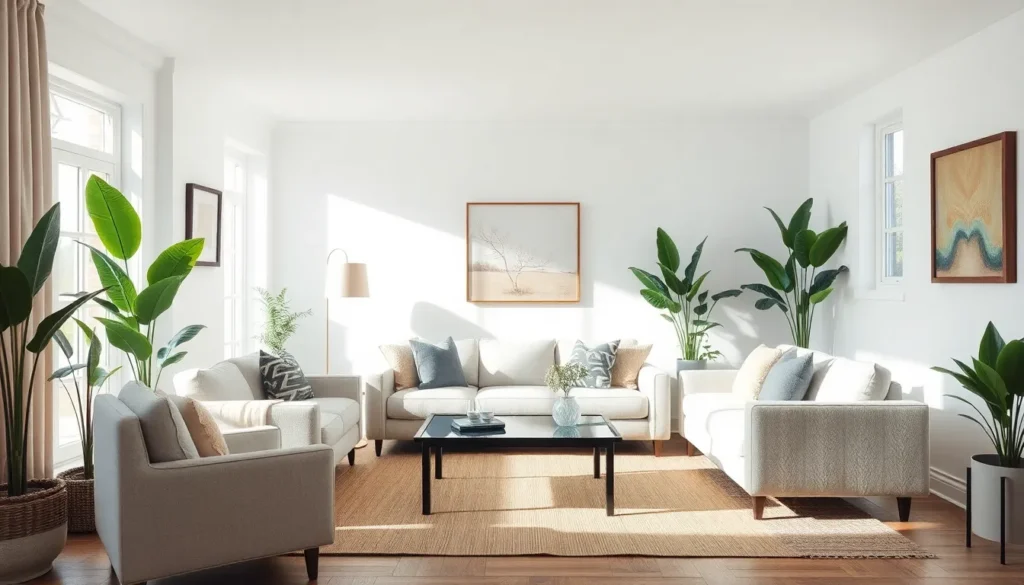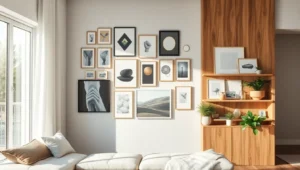Selling a home can feel like a circus act, juggling open houses and endless showings while trying to keep your sanity intact. But fear not! Home staging is your secret weapon to transform your space from “lived-in” to “wow, I need this in my life!” With a few clever tweaks, you can make potential buyers picture themselves sipping coffee in that sunlit corner or hosting epic dinner parties in your stylish dining room.
Table of Contents
ToggleImportance Of Home Staging
Home staging increases a property’s appeal and value. A well-staged home showcases its best features, attracting more potential buyers. Statistically, staged homes sell 73% faster than non-staged ones, highlighting its effectiveness in a competitive market.
Creating an inviting atmosphere encourages buyers to envision themselves in the space. Color schemes, furniture arrangement, and decor choices all play pivotal roles in this visualization. Effective staging can also reduce time on the market and increase sale prices.
Investing in home staging commonly translates to higher offers. Buyers often perceive staged homes as well-maintained, leading to greater confidence in their purchase decisions. Emotional connections fostered through well-designed spaces frequently influence buyer behavior.
Sellers who prioritize home staging experience noticeable differences. Attention to detail in every room, from the kitchen to the living area, enhances the overall experience. Rooms appear larger and more functional with effective staging techniques.
In busy real estate markets, standing out becomes essential. Home staging serves as a marketing strategy that transforms a property into a more desirable product. Visual appeal ultimately captivates potential buyers, making them more inclined to make an offer.
Key Home Staging Tips

Home staging enhances property appeal, showcasing its best features. Sellers can implement specific strategies to create an inviting atmosphere.
Declutter and Depersonalize
A clutter-free space allows potential buyers to envision their own lives within it. Remove personal items such as family photos and memorabilia, creating a neutral backdrop. Minimalist decor can highlight each room’s functionality. Furniture should be rearranged to optimize flow, giving buyers a sense of spaciousness. This step prioritizes essential items while ensuring surfaces remain clear and organized. Determine what adds value to the space and eliminate distractions.
Choose The Right Color Palette
An inviting color palette influences buyer perception significantly. Opt for neutral shades to appeal to a broader audience. Light tones make spaces feel airy and open, drawing attention to architectural features. Accent colors can add warmth; consider using them sparingly in decor items. Choose furnishings that complement the color scheme, creating cohesion throughout the home. Prioritize consistency to help potential buyers feel more comfortable and connected to the space.
Maximize Lighting
Effective lighting can transform any room, making it feel inviting. Utilize natural light wherever possible; open blinds and drapes to let in sunlight. Incorporate layered lighting for a warm ambiance; combine overhead lighting with floor and table lamps. Dimmer switches can adjust the mood based on the time of day. Prioritize lighting fixtures that enhance the home’s style while ensuring every space feels bright and welcoming. This focus captures attention immediately and highlights the property’s best attributes.
Furniture Arrangement Strategies
Effective furniture arrangement creates a sense of flow and space, making a home inviting. Ensuring furniture is not overcrowded allows for easy movement and adds to the overall spaciousness. Grouping furniture into functional zones encourages interaction, which highlights the home’s usability. Consider using area rugs to define different spaces within larger rooms. Arranging seating to face each other fosters conversation and warmth, helping buyers feel at home. Maintaining symmetry in arrangement provides visual balance, making rooms more appealing.
Create Flow and Space
Creating flow and space enhances the property’s overall appeal. Positioning furniture away from walkways minimizes obstructions, allowing smoother traffic flow. Open pathways between furniture arrangements ensure buyers can navigate rooms effortlessly. Using appropriately-sized furniture prevents cramped quarters, making the space feel larger. Incorporating multipurpose furniture serves practical needs and optimizes functionality, appealing to a wider audience. Utilizing vertical space with shelves or tall decor adds interest without cluttering floor space, making rooms feel airy.
Highlight Focal Points
Highlighting focal points draws attention to the home’s best features. Centering furniture around a fireplace or large window emphasizes natural light and warmth. Adding art pieces or statement decor near seating arrangements guides buyer attention to key areas. Placing mirrors strategically expands the sense of space while reflecting light, enhancing room brightness. Directing lighting fixtures towards focal points accentuates architectural details, making them stand out. Special attention to the arrangement of accessories adds personality without overwhelming the space, keeping it inviting and cohesive.
Accessories and Decor Suggestions
Incorporating accessories and decor can significantly enhance a home’s appeal during the staging process.
Use Mirrors to Expand Space
Mirrors serve as a valuable tool in home staging. They create an illusion of depth and openness, making smaller rooms appear larger. Strategically placing mirrors across from windows captures natural light, brightening the area. They can also reflect attractive views, drawing attention to desirable features. Choosing oversized mirrors for expansive walls adds a dramatic touch, further enhancing spaciousness. With various styles, from modern to vintage, it’s possible to match mirrors to the room’s decor, ensuring a cohesive look.
Add Greenery for Freshness
Introducing greenery brings life to any space. Plants contribute not only color but also freshness, creating a welcoming environment. Choosing low-maintenance options, like succulents or snake plants, ensures that upkeep remains manageable during showings. Placing potted plants in corners or on shelves enhances visual interest without overwhelming the space. Fresh flowers in vases offer a pop of color and can elevate mood, appealing to buyers on an emotional level. When integrating greenery, aim for a balanced distribution throughout the home, promoting a serene atmosphere.
Home staging is a vital step in the selling process that can significantly impact a property’s marketability. By creating an inviting and neutral environment, sellers can help potential buyers envision their future in the space. The right color palette, effective furniture arrangements, and strategic decor choices can transform a home into a desirable product.
In a competitive real estate market, staging not only enhances appeal but also fosters a sense of confidence in buyers. With the right approach, sellers can expect quicker sales and potentially higher offers. Prioritizing home staging is more than just a trend; it’s a smart investment that can lead to successful transactions.





